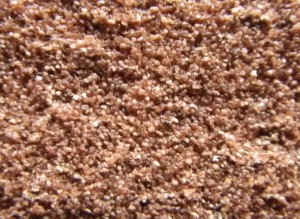The West Midlands Safari Park sits almost exclusively upon Permian-aged Bridgnorth Sandstone, approximately 299 million years old.
During Permian times the Geopark area was a vast desert sat landlocked 20 degrees north of the equator on a single continent known as Pangea. The wind was blowing sand dunes across the desert whilst occasional flash floods deposited alluvial fans. Bridgnorth Sandstone represents these fossilised sand dunes.

Close up of Bridgnorth Sandstone
Close inspection of a typical Bridgnorth Sandstone shows the grains of sand within are well rounded and polished by abrasion as they bounced against each other across the desert surface. The sand is dyed red by iron oxide which weakly cements the grains of quartz together.
Permian Bridgnorth Sandstone display the feature known as dune-bedding in which one set of dunes has been partly eroded and then covered by a new set. This gives rise to a distinctive criss-cross pattern of bedding in the rock. By looking at the shape of these fossilised dunes it is possible to determine the predominant wind direction 300 million years ago when the dunes were formed. Analysis indicates south-east winds which correlates with sub-tropical trade winds found at 20 degrees north of the equator today.
The Land of the Living Dinosaurs exhibit at the West Midlands Safari Park starts its story in Permian times with the carnivorous Gorgonops, a therapsid. At the end of the Permian period a mass extinction event occurred; a key event in the history of the Earth marking a major overturn of ecosystems. Following the Permian, the Land of the Living Dinosaurs exhibit explores the Triassic Period which saw the rise of the Eoraptor which is widely regarded as the first ‘true’ dinosaur. The exhibit continues to travel through time exploring the times when dinosaurs ruled the earth and closes its journey in modern times.



